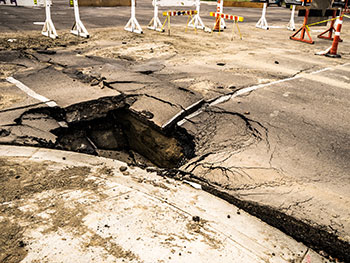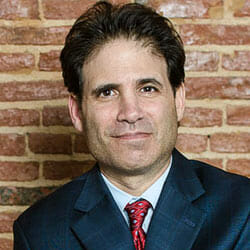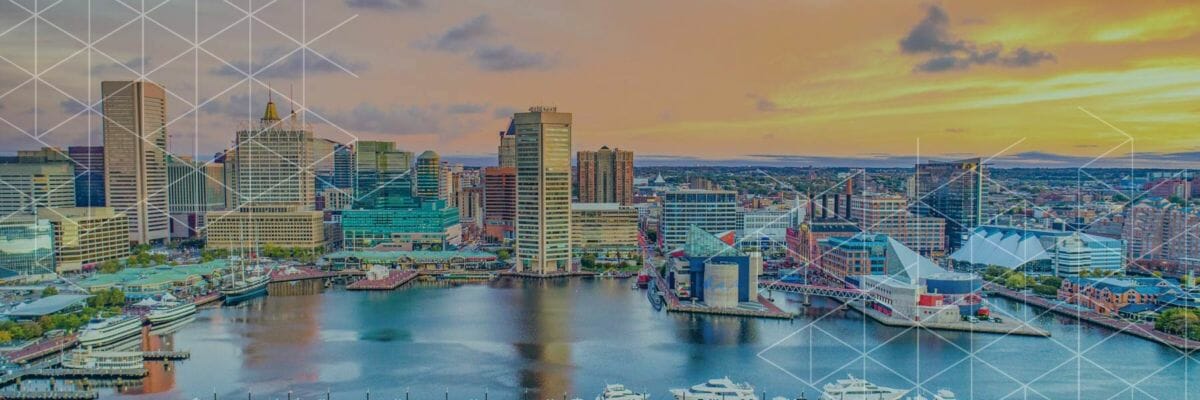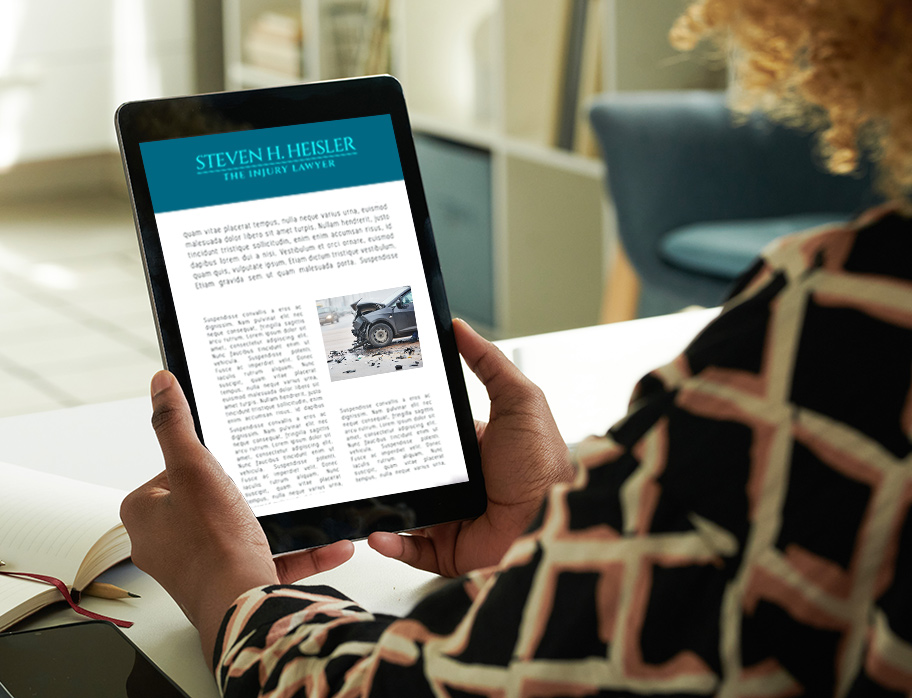Road Work Ahead: Our Failing Bridges, Highways, and Streets
Our Interstate highway system turns 60 in 2016. Signed into being by President Eisenhower, it radically spurred economic and social expansion in our country. Over the past 60 years, we’ve built bridges and roads at a pace that far outstripped the rest of the world. Our national road transportation network now encompasses over 46,000 miles of interstate highway and 575,000 highway bridges.
These days, many of us take the system for granted and embark on road trips that our grandparents (or even parents) might not have seriously contemplated. But we have not maintained our roads and bridges well, especially in the past 35 years or so. Thus, the infrastructure chickens are coming home to roost, with reports of accidents and catastrophic bridge failures. At one time the envy of the world, our crumbling bridges and roads are not only costing us billions a year—they also cost us lives.
The Growing Falling-Apart Problem
 Our maintenance needs for our vehicular infrastructure continue to grow exponentially even as we fall farther behind. While Congress passed a $305 billion highway bill in December 2015 to fund repairs over five years, the chronic shortfall of the Federal Highway Trust Fund’s bottom line remains unfunded. A number of experts say that this bill is too little, too late, and that our roadway problems have reached critical mass.
Our maintenance needs for our vehicular infrastructure continue to grow exponentially even as we fall farther behind. While Congress passed a $305 billion highway bill in December 2015 to fund repairs over five years, the chronic shortfall of the Federal Highway Trust Fund’s bottom line remains unfunded. A number of experts say that this bill is too little, too late, and that our roadway problems have reached critical mass.
Why has the situation grown so abysmal? It’s no accident—we haven’t done our job as a nation. Before the December 2015 bill, the last major infrastructure funding bill was passed in 1997. Not only that, 2008’s financial crisis caused roadway maintenance spending outlays to crash right along with our economy. Innumerable decisions by lawmakers over the years have consistently put other budgetary considerations ahead of the need to keep our bridges and roads in good repair. As a result, our system is falling apart.
Consider the following facts:
- The Federal Highway Administration says that, as of 2008, almost half—that’s more than 150,000 miles—of federal (interstate and non-interstate) roadways were in either poor, mediocre, or fair condition. In major metropolitan areas, the figures amounted to nearly two-thirds of roadways. In cities such as Los Angeles, San Francisco, New York City and New Orleans, rough road conditions mean that vehicle owners paid as much as $750 per year in extra maintenance costs—back in 2008. Figures today can be higher.
- In general, bad road conditions cost all of us $67 billion a year in repairs and operating costs, according to the American Association of State Highway and Transportation Officials.
- “Structurally deficient” is how the U.S. Department of Transportation rates 12 percent (71,000) of our bridges. In some states, the deficiency percentage is over 20. Deficiency means that a bridge has a major support weakness or a bridge’s deck is fissuring and deteriorating.
- The average useful lifespan of a bridge is 50 years. The average age of our bridges is 43. At present, over 185,000 bridges are more than 50 years old, and that number could double by the year 2030.
- The 2013 grade for the USA’s bridges and roads—from the American Society of Civil Engineers’ (ASCE) Report Card for America’s Infrastructure—is a D-plus. (Maryland’s grade, from 2011, is a C-minus.) The ASCE estimates that an investment in our infrastructure of more than $3.6 trillion of federal and state money combined is needed by 2020.
Hazards That Really Happened
Bridge failures are perhaps the most extreme of roadway problems. They sometimes happen because of situations beyond our control, such as flooding that washes away bridge supports. But sometimes people are injured or die as a direct result of neglected maintenance. The following three catastrophic bridge failures are all directly due to neglected or shoddy maintenance:
- June, 1983: The Mianus River Bridge, Greenwich, Connecticut, on I-95, partially collapsed, killing three and injuring five. Metal corrosion and fatigue/deferred maintenance were the causes.
- April, 1989: The Tennessee Hatchie River Bridge, between Covington, TN, and Henning, TN, collapsed totally. The deterioration of foundation timber piles was the cause, with eight killed.
- August, 2007: The Minneapolis I-35W bridge over the Mississippi River collapsed totally, killing 13 and injuring 145. The NTSB said that undersized gusset plates, increased concrete surfacing load, and weight of construction supplies/equipment caused this collapse.
Several other examples exist where people died, with bad infrastructure as a contributing but not a primary cause.
 Highway and street dangers are generally less dramatic than bridge failures. But any number of serious accidents can occur as a result of potholes, rough surfaces, uneven shoulders, steep drop-offs, large bumps, and poorly banked curves. Many of these are the direct result of insufficient or badly done maintenance, and all of them can cause a driver to lose control.
Highway and street dangers are generally less dramatic than bridge failures. But any number of serious accidents can occur as a result of potholes, rough surfaces, uneven shoulders, steep drop-offs, large bumps, and poorly banked curves. Many of these are the direct result of insufficient or badly done maintenance, and all of them can cause a driver to lose control.
Perhaps more disturbing are the accidents resulting from chunks of concrete falling from disintegrating overpasses. In 2015 alone, there have been at least three significant incidents, one in our own area:
- A hunk of concrete plummeted from a Morningside overpass on I-495. The car was damaged, but fortunately the woman driving was not. After the incident, Maryland’s Acting Transportation Secretary Pete K. Rahn ordered the immediate inspection of 27 bridges.
- In Tulsa, OK, a chunk of concrete dropped off a bridge, damaging a car and closing a portion of the Broken Arrow Expressway while the bridge was inspected. No one was hurt.
- Large pieces of concrete, some as big as a football, fell from an I-80 overpass in West Sacramento, CA. Fortunately, no one was injured.
The Maryland lawyer who represented the woman whose car was damaged in the Morningside overpass concrete-chunk incident expressed thoughts that a growing number of people have. “My biggest fear is that once this is no longer in the headlines it will fall by the wayside. It concerns me that we have this focus on our aging infrastructure only when you have pieces of concrete falling on a motorist.”
One last local story—consider the Frederick Douglass Memorial Bridge that carries drivers into Washington, DC, providing a picture-perfect view of the U.S. Capitol building. The view of the bridge, on the other hand, is plug-ugly, with dangerously thinning steel underpinnings, copious rust, and disintegrating concrete. Officials in DC have shored up the horizontal beams to keep the bridge from falling into the Anacostia River—that’s how agitated they are about a catastrophic collapse.
Monetary Costs and Human Costs
With the examples above, we’ve covered some of the human losses due to injury and death. But there are other human costs as well, many of them also involving money. Lost time from sitting in traffic jams caused by insufficient or damaged roadways, wasted fuel, and increased costs of operating your car—it all adds up. A 2013 study estimated that these problems cost the average Baltimore-area driver $1,781 per year. The Washington-area driver has it even worse: $2,195 in extra outlays.
And the trucking industry, which often bears the brunt of bad roads and traffic delays, spends enough to cost the average U.S. citizen an extra $29 per year. That may not seem like a lot to you. But if you do the math, it amounts to almost an additional $10 billion a year in extra costs—all because we aren’t fixing our roads and bridges.
Recent Technological Developments
Technology may be of some help in the near future. In Panama, a small disc, designed to be inserted into a road defect (such as a pothole), made the news during the summer of 2015. The “tweeting pothole” uses Twitter to send a message to Panama’s national Department of Public Works every time someone drives over the pothole.
This story eventually went viral, making it clear that people all over the world are interested in fixing infrastructure problems. But this tale also gives us a hint of how technology might help us. Alerts sent through either social media or more official channels could perhaps save us from the trouble that a road defect can cause. It might even keep a small road problem from becoming a big one by causing it to get repaired sooner. Right now, cities and towns rely on citizens to phone in their reports of potholes and other problems, a decidedly inefficient, low-tech way to deal with the problem.
Smartphone apps are getting into the act to improve the situation. StreetBump, created by the city of Boston, can detect the locations of potholes by sensing the jolts that the vehicles experience while they are driven. The information is then passed on to the city so that they can fix the potholes.
But tech that watches for problems becomes critical when it comes to preventing bridge disasters. When the 2007 I-35W Minneapolis bridge that collapsed was rebuilt (it’s now called the St. Anthony Falls Bridge), it was constructed as a “smart bridge.” Researchers at the University of Minnesota now monitor the 500 sensors that measure the bridge’s weight load, sway, and structural integrity for signs of physical degradation. If you think about it, this kind of technology is rather similar to the “tweeting pothole.”
Road and bridge construction is also being changed by new ways of doing things, although the practice is still in its infancy. Certain bridges can now be constructed somewhere else, brought to the site, and put in place within several days’ time, avoiding a long construction project that snarls traffic for months or even years.
Believe it or not, drones are one more possibility. Some researchers at Michigan Technological University have outfitted the unmanned aerial machines with the necessary scientific tools to inspect gravel roads. The drones enable them to zero in on problems more effectively than relying on driver reports. Such reports mean that a human being has to go assess the situation in person. It’s possible that the usage of drones could be expanded to keep an eye on our millions of miles of paved roads.
However, there’s one thing we all need to remember. Although technology can reduce some of the human costs of our infrastructure problems—it can likely lessen the number of people who are injured, and alleviate some of the lost time and money due to traffic delays, for example—it still can’t rebuild the roads themselves. For that, we need funding allocated to seriously tackle the problems of the enormous number of substandard roads (one-fourth of major urban-area roads) and the over 67,000 bridges that are either closed or have usage restrictions. If we don’t take care of the problems soon, the cost in lost time and money, and especially in human life, is only going to increase.
We’re listening. How can we help?
The aftermath of a vehicle collision can be life-changing for the accident victims and their family, and often takes years of patience and dedication to overcome. Accidents caused by poor-quality roads and infrastructure can involve multiple parties and can rapidly grow in complexity. If you believe another party or parties are responsible for the injuries or losses you have suffered in a Maryland car crash, Steve Heisler can help you get your life back on track. Steve has focused exclusively on personal injury law for nearly 20 years, always working hard to ensure that accident victims receive the compensation they deserve to help pay off medical bills, physical therapy and other rehabilitative care, lost wages, vehicle repair or replacement, and other accident-related costs.
Contact the Law Offices of Steven H. Heisler today. We can help you obtain compensation for injuries you or your family member sustained. Call (410) 625-4878 for a free consultation, or use our online form.

Attorney Steve Heisler
Steve Heisler decided in 1996 that he was going to focus his law practice exclusively on injury cases. Since then, he has been representing injured people against insurance companies, disreputable medical practitioners and Big Pharma, and doing it with compassion, honesty and level-headed rationality. [ Attorney Bio ]


